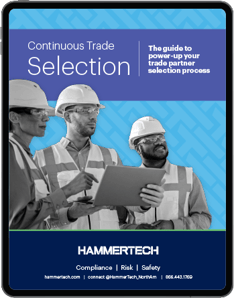Current industry trends around subcontractor selection are changing. To help, we've pulled out some of the most critical information from our comprehensive guide developed with DPR Construction and Digital Realty.
Industry Headwinds
Managing trade partner collaboration is vital, as the potential benefits and pitfalls can have far reaching ramifications throughout the construction process. Inefficiency, low safety ratings, unengaged workforce, and ultimately lower profit margins are just a few issues one can expect from mismanaged trade partner selection.
Building strong relationships with trade partners is a significant and ongoing task. If those relationships begin at the start of a project, as they often do, then your opportunity to safely scale while increasing profit margins, is to transition into ongoing partnerships.
Common constraints that inhibit our ability to select and mature quality trade partners are:
• One-time partnering culture
• Manual processes
• Too many or unintegrated systems
• Reliance on historical lagging data which has limited use for predicting future performance
• Labor shortages
"The biggest headwind is transitioning the mindset from a paper or static process to a digital dynamic process. Our dynamic processes allows us to connect globally, and draw action from a single source of truth."
– Thomas Barnard,
Director HSE- Construction, Digital Realty
Continuous Selection Method
A shift in the use of compliance, risk and safety data is emerging to help subcontractor selection.
These trends are emerging three-fold:
1. The use of action-based data to assess the performance of a trade partner.
2. Data-based selection of trades on a continuous basis (rather than ad hoc) to paint a forward-looking picture lagging metrics cannot.
3. The sharing of general contractors’ safety data with trades to improve action-based coaching.
The benefits general contractors are seeing as a result of shifting selection practices include increased efficiency, better project outcomes, more engaged workforce, and improved profitability.
Forward-Looking Indicators for Success
Data under all pillars is important. Utilizing lagging indicators in a consistent process provides insights as a predictive tool.
To have more confidence trade partners will perform, we want to balance past performance with potential every time we appoint them to a project. We also want to see over the course of different projects if they’re adjusting for the better or perhaps for the worse. That’s why it’s important to understand the limitations of lagging data as a predictive tool.
Lagging indicators are sometimes the best yardstick available. But it’s important to understand their limitations as a predictive tool.
Here are some indicators that can be used to anticipate future success.
1. Certified Employees
2. Labor Hours
3. Pre-Task Plans
4. Hazard Assessment Trainings
5. Observations
6. Corrective Action Close out Rate
7. Weekly Stand-downs
8. Attendance Inspections
9. Facilitated communication e.g. Daily Briefings
Making Action Visible to Drive Desired Outcomes
Growing with suppliers orients an organization toward continual improvement, which should be the headline goal of every compliance, risk and safety management system.
Establishing and cementing those relationships should include demonstrable performance metrics in line with your benchmarks and specified goals.
1. Make it simple for trades to engage.
2. Make it Simple to measure the engagement.
3. Share results early & often with trades & project team (not just safety) to progressively course correct.
In an ideal scenario, all jobsite processes will be completed via a mobile-first platform that ensures everyone on the jobsite can engage and collaborate with compliance, risk and safety processes appropriate to their job.
The Continuous Selection Cycle
This is the most critical stage to ensure you realize value from your efforts. This is how we turn engaged trades and action-based data into a cycle for continuous selection.
Past performance isn't always indicative of future results. What drives the future are the actions we take today.
1. Use quantified data to benchmark trade partners across business
2. Make it easy for wider GC teams to access leading data to support procurement
3. Offer opportunities to engage and improve, hold workshops and offer resources to close gaps
4. Stick to your guns at contract time
Find this quick guide useful?
Download the comprehensive guide today!







